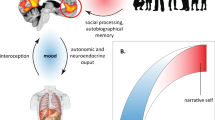Abstract
The concepts of identity, self and self-representation have been discussed extensively in psychoanalytic metapsychology. These concepts are at times confusing and are used interchangeably by various authors. Regardless of what one calls it, what one experiences in a given moment is one's representation as an analyst or a father or a son or daughter, depending on the situation one is in. This paper describes such state-dependent self-representations as an aspect of the self and argues that state-dependent self-representations are probably more clinically relevant and useful in day-to-day practice.
Similar content being viewed by others
References
Akhtar, S. (1999). Immigration and identity: turmoil, treatment and transformation. Northvale, NJ: Jason Aronson Inc.
Blum, H.P. (1982). Theories of the self and psychoanalytic concepts: Discussion. Journal of the American Psychoanalytic Association, 30, 959–978.
Denenberg, V. & Bell, R. (1960). Critical periods for the effects of infantile experience on adult learning. Science, 131 (3395), 227–228.
Falkenström, F. (2003). A Buddhist contribution to the psychoanalytic psychology of self. International Journal of Psychoanalysis, 84, 1551–1568.
Fonagy, P., Gergely, G., Jurist, E.L. & Target, M. (2002). Affect regulation, mentalization, and the development of the self. New York: Other Press.
Fridhandler, B. & Tunis, S. (1992). Theoretical and methodological comments on self-representation. Psychological Inquiry, 3, 38–40.
Hartmann, H. (1950). Comments on the psychoanalytic theory of the ego. Psychoanalytic Study of the Child, 5, 74–96.
Jacobson, E. (1964). The self and the object world. New York: International Universities Press.
Kakar, S. (1983). The inner world: a psychoanalytic study of Hindu childhood and society. (2nd edn., July 7) Oxford, UK: Oxford University Press.
Kandel, E. (2006). In search of memory: the emergence of a new science of mind. New York: W.W. Norton.
Kernberg, O.F. (1982). Self, ego, affects, and drives. Journal of the American Psychoanalytic Association, 30, 893–917.
Kurtz, S. (1992). All the mothers are one. New York: Columbia University Press.
Lacan, J. (2004). The mirror stage as formative of the function of the I as revealed in psychoanalytic experience. In B. Fink (Trans.) Écrits: a selection (pp. 3–9) New York: Norton (Original work published 1949).
Lou, H., Luber, B., Crupain, M., Keenan, J.P., Nowak, M., Kjaer, T.W., Sackeim, H. & Lisanby, S. (2004). Parietal cortex and representation of the mental self. Proceedings of the National Academy of Sciences of the United States of America, 101 (17), 6827–6832.
Okimoto, J. (2001). The appeal cycle in three cultures: An exploratory comparison of child development. Journal of the American Psychoanalytic Association, 49 (1), 187–215.
Pande, S. (1968). The mystique of “Western” psychotherapy: An Eastern interpretation. Journal of Nervous and Mental Disease, 146, 425–432.
Pratt Ewing, K. (1997). Arguing sainthood: modernity, psychoanalysis, and Islam. North Carolina: Duke University Press.
Racamier, P.C. (1963). Sur la personnation. In De psychanalyse en psychiatrie. Paris: Payot.
Roland, A. (1991). In search of self in India and Japan. Princeton, NJ: Princeton University Press.
Sandler, J. & Rosenblatt, B. (1962). The concept of the representational world. Psychoanalytic Study of the Child, 17, 128–145.
Squire, L.R. (1987). Memory and the brain. (1st edn., March 5). UK: Oxford/USA: Oxford University Press.
Westen, D. (1990). The relations among narcissism, egocentrism, self-concept, and self-esteem: Experimental, clinical, and theoretical considerations. Psychoanalysis and Contemporary Thought, 13, 183–239.
Westen, D. (1992). The cognitive self and the psychoanalytic self: Can we put our selves together? Psychological Inquiry, 3, 1–13.
Wheelis, A. (1958). The quest for identity. New York: Norton.
Author information
Authors and Affiliations
Corresponding author
Additional information
1M.D., M.A., is Lecturer at Columbia University Center for Psychoanalytic Training and Research, and Associate Chief of Psychiatry at the Department of Neurosciences, New York Methodist Hospital.
Rights and permissions
About this article
Cite this article
Ghorpade, A. State-Dependent Self-Representations: A Culture-Bound Aspect of Identity. Am J Psychoanal 69, 72–79 (2009). https://doi.org/10.1057/ajp.2008.40
Published:
Issue Date:
DOI: https://doi.org/10.1057/ajp.2008.40




